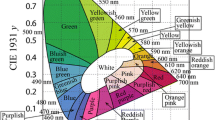Thin luminescent films of the organometallic complex of lithium 8-hydroxyquinolate Liq on glass substrates were fabricated by capillary deposition and lithography. The spectral-luminescent properties of the obtained film structures were investigated. The film surface was analyzed. The light yield and the kinetics of scintillation emission of the obtained film structures are estimated.







Similar content being viewed by others
References
R. Yu. Shendrik, Introduction to the Physics of Scintillators, Part 1, Textbook [in Russian], Izd. IGU, Irkutsk (2013),
M. J. Weber, “Scintillation: mechanisms and new crystals,” Nucl. Instr. Methods Phys. Res., Sec. A. Accelerators, Spectrometers, Detectors and Associated Equipment, 527, 9 – 14 (2004).
P. Lecoq, A. Gektin, M. Korzhik, et al., Inorganic Scintillators for Detector Systems: Physical Principles and Crystal Engineering, Springer (2016).
N. J. Cherepy, et al., “Transparent ceramic scintillators for gamma spectroscopy and radiography,” Hard X-Ray, Gamma-Ray, and Neutron Detector Physics XII. International Society for Optics and Photonics. 7805, 780501 (2010).
N. J. Cherepy, J. D. Kuntz, Z. M. Seeley, et al., “Transparent ceramic scintillator fabrication, properties, and applications,” Hard X-Ray, Gamma-Ray, and Neutron Detector Physics X. – International Society for Optics and Photonics, 7079, 70790X (2008).
Z.W. Bell, C. H. Ho, G. M. Brown, and F. V. Sloop Jr, “Organic scintillators for neutron detection,” X-Ray and Gamma-Ray Detectors and Applications, IV. International Society for Optics and Photonics, 4784, 150 – 163 (2003).
F. So, Organic Electronics. Materials, Processing, Devices and Applications, CRC Press, New York (2010).
D. Singh, V. Nishal, S. Bhagwan, et al., “Electroluminescent materials: Metal complexes of 8-hydroxyquinoline: A review,” Mater. Design, 156, 215 – 228 (2018).
K. I. Runina, L. V. Popkova, R. I. Avetisov, et al., “Capillary method for obtaining luminescent hybrid films,” in: Optics and Spectroscopy of Condensed Media: 27th Intern. Scientific Conf., Krasnodar, 26 Sept. – 2 Oct. 2021 [in Russian], Krasnodar (2021), pp. 179 – 183.
M. Zykova, K. Runina, L. Popkova, et al., “Luminescent properties of organic – inorganic hybrid films fabricated by capillary coating technique,” Appl. Phys. A, 128(3), 240 (2022).
Y.Wan, M. Raven, E. Inameti, and B. Murray, “YBCO thin film device fabrication using lithographic techniques,” Vacuum, 43, 67 – 70 (1992).
S. Dai, Y. Wang, D. Zhang, et al., “Fabrication of surface-patterned ZnO thin films using sol-gel methods and nanoimprint lithography,” J. Sol-Gel Sci. Technol., 60, 17 – 22 (2011).
L. N. Maskaeva, E. A. Fedorova, and V. F. Markov, Technology of Thin Films and Coatings, Textbook [in Russian], Izd. Ural. Univer., Ekaterinburg (2019).
A. V. Kazarbin, Investigation of the Operation of a Scintillation Counter: Guidelines for Laboratory Work No 68-1 in Physics for Students of All Forms of Education [in Russian], Izd. Tikhookeansk. Gos. Univer., Khabarovsk (2009).
Yu. V. Melikov, Experimental Methods in Nuclear Physics: Lectures [in Russian], Izd. MGU, Moscow (1996).
This work was performed as part of the financing of the applied research project of the D. I. Mendeleev University Chemical Technology of Russia NoVIG 2022-062.
The authors are grateful to the project “Tropical Materials Science: Protection of Technologies and Materials from External Impacts of Tropical Climate” (Ekolan T-1.7) for the opportunity to investigate film stability in tropical climate conditions at the Vietnam-Russian Tropical Center.
Author information
Authors and Affiliations
Corresponding author
Additional information
Translated from Steklo i Keramika, No. 12, pp. 56 – 62, December, 2022.
Rights and permissions
Springer Nature or its licensor (e.g. a society or other partner) holds exclusive rights to this article under a publishing agreement with the author(s) or other rightsholder(s); author self-archiving of the accepted manuscript version of this article is solely governed by the terms of such publishing agreement and applicable law.
About this article
Cite this article
Runina, K.I., Zykova, S.S., Strekalov, P.V. et al. Obtaining a New Film Scintillator Based on (8-oxyquinolate) Lithium: An Overview. Glass Ceram 79, 522–525 (2023). https://doi.org/10.1007/s10717-023-00544-2
Received:
Published:
Issue Date:
DOI: https://doi.org/10.1007/s10717-023-00544-2




